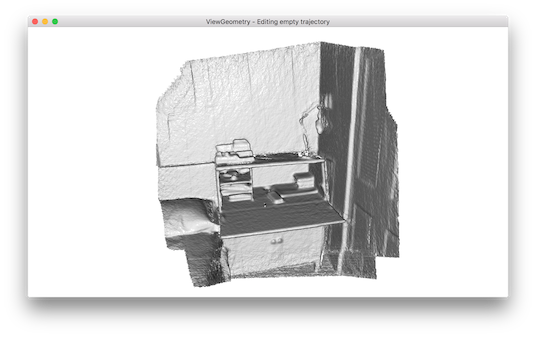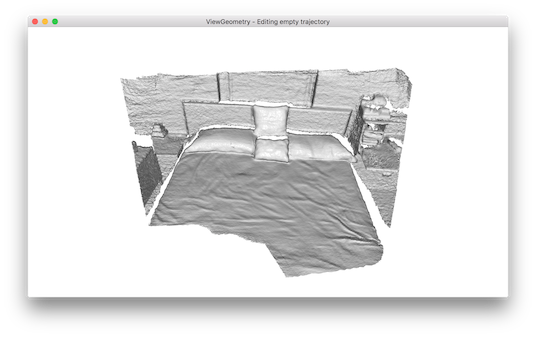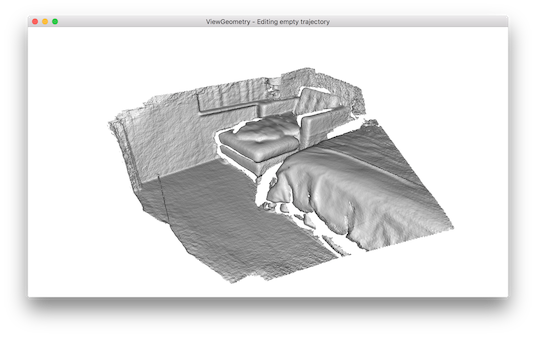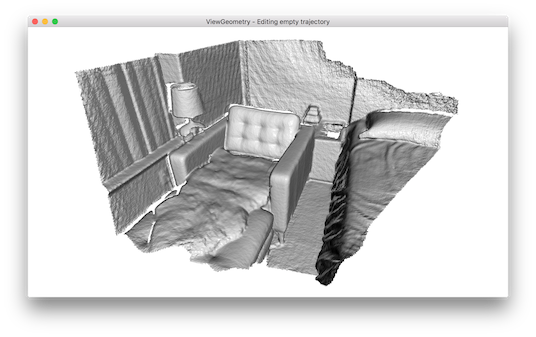Make fragments¶
The first step of the scene reconstruction system is to create fragments from short RGBD sequences.
Input arguments¶
The script runs with python run_system.py [config] --make. In [config], ["path_dataset"] should have subfolders image and depth to store the color images and depth images respectively. We assume the color images and the depth images are synchronized and registered. In [config], the optional argument ["path_intrinsic"] specifies the path to a json file that stores the camera intrinsic matrix (See Read camera intrinsic for details). If it is not given, the PrimeSense factory setting is used instead.
Register RGBD image pairs¶
34 35 36 37 38 39 40 41 42 43 44 45 46 47 48 49 50 51 52 53 54 55 56 57 58 59 60 | # examples/Python/ReconstructionSystem/make_fragments.py
def register_one_rgbd_pair(s, t, color_files, depth_files, intrinsic,
with_opencv, config):
source_rgbd_image = read_rgbd_image(color_files[s], depth_files[s], True,
config)
target_rgbd_image = read_rgbd_image(color_files[t], depth_files[t], True,
config)
option = o3d.odometry.OdometryOption()
option.max_depth_diff = config["max_depth_diff"]
if abs(s - t) is not 1:
if with_opencv:
success_5pt, odo_init = pose_estimation(source_rgbd_image,
target_rgbd_image,
intrinsic, False)
if success_5pt:
[success, trans, info] = o3d.odometry.compute_rgbd_odometry(
source_rgbd_image, target_rgbd_image, intrinsic, odo_init,
o3d.odometry.RGBDOdometryJacobianFromHybridTerm(), option)
return [success, trans, info]
return [False, np.identity(4), np.identity(6)]
else:
odo_init = np.identity(4)
[success, trans, info] = o3d.odometry.compute_rgbd_odometry(
source_rgbd_image, target_rgbd_image, intrinsic, odo_init,
o3d.odometry.RGBDOdometryJacobianFromHybridTerm(), option)
return [success, trans, info]
|
The function reads a pair of RGBD images and registers the source_rgbd_image to the target_rgbd_image. Open3D function compute_rgbd_odometry is called to align the RGBD images. For adjacent RGBD images, an identity matrix is used as initialization. For non-adjacent RGBD images, wide baseline matching is used as an initialization. In particular, function pose_estimation computes OpenCV ORB feature to match sparse features over wide baseline images, then performs 5-point RANSAC to estimate a rough alignment, which is used as the initialization of compute_rgbd_odometry.
Multiway registration¶
62 63 64 65 66 67 68 69 70 71 72 73 74 75 76 77 78 79 80 81 82 83 84 85 86 87 88 89 90 91 92 93 94 95 96 97 98 99 100 101 102 103 104 105 106 107 108 109 | # examples/Python/ReconstructionSystem/make_fragments.py
def make_posegraph_for_fragment(path_dataset, sid, eid, color_files,
depth_files, fragment_id, n_fragments,
intrinsic, with_opencv, config):
o3d.utility.set_verbosity_level(o3d.utility.VerbosityLevel.Error)
pose_graph = o3d.registration.PoseGraph()
trans_odometry = np.identity(4)
pose_graph.nodes.append(o3d.registration.PoseGraphNode(trans_odometry))
for s in range(sid, eid):
for t in range(s + 1, eid):
# odometry
if t == s + 1:
print(
"Fragment %03d / %03d :: RGBD matching between frame : %d and %d"
% (fragment_id, n_fragments - 1, s, t))
[success, trans,
info] = register_one_rgbd_pair(s, t, color_files, depth_files,
intrinsic, with_opencv, config)
trans_odometry = np.dot(trans, trans_odometry)
trans_odometry_inv = np.linalg.inv(trans_odometry)
pose_graph.nodes.append(
o3d.registration.PoseGraphNode(trans_odometry_inv))
pose_graph.edges.append(
o3d.registration.PoseGraphEdge(s - sid,
t - sid,
trans,
info,
uncertain=False))
# keyframe loop closure
if s % config['n_keyframes_per_n_frame'] == 0 \
and t % config['n_keyframes_per_n_frame'] == 0:
print(
"Fragment %03d / %03d :: RGBD matching between frame : %d and %d"
% (fragment_id, n_fragments - 1, s, t))
[success, trans,
info] = register_one_rgbd_pair(s, t, color_files, depth_files,
intrinsic, with_opencv, config)
if success:
pose_graph.edges.append(
o3d.registration.PoseGraphEdge(s - sid,
t - sid,
trans,
info,
uncertain=True))
o3d.io.write_pose_graph(
join(path_dataset, config["template_fragment_posegraph"] % fragment_id),
pose_graph)
|
This script uses the technique demonstrated in Multiway registration. Function make_posegraph_for_fragment builds a pose graph for multiway registration of all RGBD images in this sequence. Each graph node represents an RGBD image and its pose which transforms the geometry to the global fragment space. For efficiency, only key frames are used.
Once a pose graph is created, multiway registration is performed by calling function optimize_posegraph_for_fragment.
12 13 14 15 16 17 18 19 20 21 22 23 24 25 26 27 28 29 30 31 32 33 34 35 36 37 38 39 40 | # examples/Python/ReconstructionSystem/optimize_posegraph.py
def run_posegraph_optimization(pose_graph_name, pose_graph_optimized_name,
max_correspondence_distance,
preference_loop_closure):
# to display messages from o3d.registration.global_optimization
o3d.utility.set_verbosity_level(o3d.utility.VerbosityLevel.Debug)
method = o3d.registration.GlobalOptimizationLevenbergMarquardt()
criteria = o3d.registration.GlobalOptimizationConvergenceCriteria()
option = o3d.registration.GlobalOptimizationOption(
max_correspondence_distance=max_correspondence_distance,
edge_prune_threshold=0.25,
preference_loop_closure=preference_loop_closure,
reference_node=0)
pose_graph = o3d.io.read_pose_graph(pose_graph_name)
o3d.registration.global_optimization(pose_graph, method, criteria, option)
o3d.io.write_pose_graph(pose_graph_optimized_name, pose_graph)
o3d.utility.set_verbosity_level(o3d.utility.VerbosityLevel.Error)
def optimize_posegraph_for_fragment(path_dataset, fragment_id, config):
pose_graph_name = join(path_dataset,
config["template_fragment_posegraph"] % fragment_id)
pose_graph_optimized_name = join(
path_dataset,
config["template_fragment_posegraph_optimized"] % fragment_id)
run_posegraph_optimization(pose_graph_name, pose_graph_optimized_name,
max_correspondence_distance = config["max_depth_diff"],
preference_loop_closure = \
config["preference_loop_closure_odometry"])
|
This function calls global_optimization to estimate poses of the RGBD images.
Make a fragment¶
111 112 113 114 115 116 117 118 119 120 121 122 123 124 125 126 127 128 129 130 131 132 133 134 135 136 137 138 139 140 141 142 143 144 145 146 | # examples/Python/ReconstructionSystem/make_fragments.py
def integrate_rgb_frames_for_fragment(color_files, depth_files, fragment_id,
n_fragments, pose_graph_name, intrinsic,
config):
pose_graph = o3d.io.read_pose_graph(pose_graph_name)
volume = o3d.integration.ScalableTSDFVolume(
voxel_length=config["tsdf_cubic_size"] / 512.0,
sdf_trunc=0.04,
color_type=o3d.integration.TSDFVolumeColorType.RGB8)
for i in range(len(pose_graph.nodes)):
i_abs = fragment_id * config['n_frames_per_fragment'] + i
print(
"Fragment %03d / %03d :: integrate rgbd frame %d (%d of %d)." %
(fragment_id, n_fragments - 1, i_abs, i + 1, len(pose_graph.nodes)))
rgbd = read_rgbd_image(color_files[i_abs], depth_files[i_abs], False,
config)
pose = pose_graph.nodes[i].pose
volume.integrate(rgbd, intrinsic, np.linalg.inv(pose))
mesh = volume.extract_triangle_mesh()
mesh.compute_vertex_normals()
return mesh
def make_pointcloud_for_fragment(path_dataset, color_files, depth_files,
fragment_id, n_fragments, intrinsic, config):
mesh = integrate_rgb_frames_for_fragment(
color_files, depth_files, fragment_id, n_fragments,
join(path_dataset,
config["template_fragment_posegraph_optimized"] % fragment_id),
intrinsic, config)
pcd = o3d.geometry.PointCloud()
pcd.points = mesh.vertices
pcd.colors = mesh.vertex_colors
pcd_name = join(path_dataset,
config["template_fragment_pointcloud"] % fragment_id)
o3d.io.write_point_cloud(pcd_name, pcd, False, True)
|
Once the poses are estimates, RGBD integration is used to reconstruct a colored fragment from each RGBD sequence.
Batch processing¶
168 169 170 171 172 173 174 175 176 177 178 179 180 181 182 183 184 185 186 187 188 | # examples/Python/ReconstructionSystem/make_fragments.py
def run(config):
print("making fragments from RGBD sequence.")
make_clean_folder(join(config["path_dataset"], config["folder_fragment"]))
[color_files, depth_files] = get_rgbd_file_lists(config["path_dataset"])
n_files = len(color_files)
n_fragments = int(math.ceil(float(n_files) / \
config['n_frames_per_fragment']))
if config["python_multi_threading"]:
from joblib import Parallel, delayed
import multiprocessing
import subprocess
MAX_THREAD = min(multiprocessing.cpu_count(), n_fragments)
Parallel(n_jobs=MAX_THREAD)(delayed(process_single_fragment)(
fragment_id, color_files, depth_files, n_files, n_fragments, config)
for fragment_id in range(n_fragments))
else:
for fragment_id in range(n_fragments):
process_single_fragment(fragment_id, color_files, depth_files,
n_files, n_fragments, config)
|
The main function calls each individual function explained above.
Results¶
Fragment 000 / 013 :: RGBD matching between frame : 0 and 1
Fragment 000 / 013 :: RGBD matching between frame : 0 and 5
Fragment 000 / 013 :: RGBD matching between frame : 0 and 10
Fragment 000 / 013 :: RGBD matching between frame : 0 and 15
Fragment 000 / 013 :: RGBD matching between frame : 0 and 20
:
Fragment 000 / 013 :: RGBD matching between frame : 95 and 96
Fragment 000 / 013 :: RGBD matching between frame : 96 and 97
Fragment 000 / 013 :: RGBD matching between frame : 97 and 98
Fragment 000 / 013 :: RGBD matching between frame : 98 and 99
The following is a log from optimize_posegraph_for_fragment.
[GlobalOptimizationLM] Optimizing PoseGraph having 100 nodes and 195 edges.
Line process weight : 389.309502
[Initial ] residual : 3.223357e+05, lambda : 1.771814e+02
[Iteration 00] residual : 1.721845e+04, valid edges : 157, time : 0.022 sec.
[Iteration 01] residual : 1.350251e+04, valid edges : 168, time : 0.017 sec.
:
[Iteration 32] residual : 9.779118e+03, valid edges : 179, time : 0.013 sec.
Current_residual - new_residual < 1.000000e-06 * current_residual
[GlobalOptimizationLM] total time : 0.519 sec.
[GlobalOptimizationLM] Optimizing PoseGraph having 100 nodes and 179 edges.
Line process weight : 398.292104
[Initial ] residual : 5.120047e+03, lambda : 2.565362e+02
[Iteration 00] residual : 5.064539e+03, valid edges : 179, time : 0.014 sec.
[Iteration 01] residual : 5.037665e+03, valid edges : 178, time : 0.015 sec.
:
[Iteration 11] residual : 5.017307e+03, valid edges : 177, time : 0.013 sec.
Current_residual - new_residual < 1.000000e-06 * current_residual
[GlobalOptimizationLM] total time : 0.197 sec.
CompensateReferencePoseGraphNode : reference : 0
The following is a log from integrate_rgb_frames_for_fragment.
Fragment 000 / 013 :: integrate rgbd frame 0 (1 of 100).
Fragment 000 / 013 :: integrate rgbd frame 1 (2 of 100).
Fragment 000 / 013 :: integrate rgbd frame 2 (3 of 100).
:
Fragment 000 / 013 :: integrate rgbd frame 97 (98 of 100).
Fragment 000 / 013 :: integrate rgbd frame 98 (99 of 100).
Fragment 000 / 013 :: integrate rgbd frame 99 (100 of 100).
The following images show some of the fragments made by this script.



